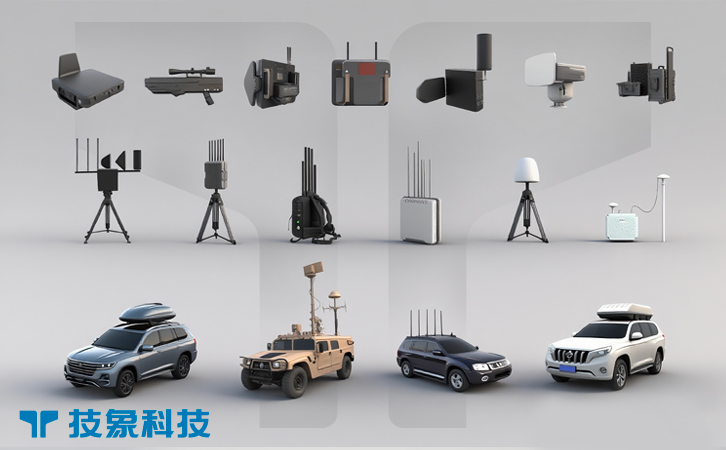Directed energy weapons (DEWs) are transforming the landscape of counter-unmanned aerial systems (C-UAS) strategies, offering precise, rapid, and cost-effective solutions to neutralize drone threats. As drones become more sophisticated and prevalent in military, civilian, and asymmetric warfare contexts, traditional methods like kinetic interceptors or jamming are increasingly supplemented by DEWs, which use concentrated energy—such as lasers or microwaves—to disable or destroy targets. By 2025, advancements in DEW technology have led to fielded systems in various militaries, addressing the growing challenges posed by drone swarms and autonomous UAS. This article examines the integration of DEWs into modern C-UAS frameworks, highlighting their mechanisms, benefits, developments, and ongoing hurdles.
I. Fundamentals of Directed Energy Weapons in C-UAS
Directed energy weapons encompass technologies that emit focused energy to disrupt or destroy targets, primarily high-energy lasers (HEL) and high-power microwaves (HPM). In C-UAS applications, HEL systems direct a concentrated beam of light to heat and damage a drone’s airframe, sensors, or propulsion systems, often causing structural failure or loss of control within seconds. For instance, systems like Raytheon’s High-Energy Laser Weapon System (HELWS) can engage small drones at ranges up to 3 kilometers, with the beam traveling at the speed of light for near-instantaneous impact. These lasers operate in the infrared spectrum, making them invisible and silent, which enhances their tactical advantage in stealthy operations.
High-power microwaves, on the other hand, emit electromagnetic pulses that overload a drone’s electronics, disrupting guidance systems, communications, or onboard computers without necessarily causing physical destruction. The U.S. Department of Defense’s THOR (Tactical High-Power Operational Responder) system exemplifies this, capable of neutralizing multiple drones simultaneously in a wide-area burst. By 2025, HPM systems have evolved to include portable variants, allowing deployment in urban or forward-operating environments. Both HEL and HPM are powered by electrical sources, providing “unlimited” shots as long as energy supply is maintained, contrasting with ammunition-limited traditional weapons.
The fundamentals of DEWs in C-UAS lie in their ability to counter the agility and low cost of drones. Drones, often small and maneuverable, can evade kinetic projectiles, but DEWs offer precision targeting through advanced optics and tracking systems integrated with radar or electro-optical sensors. For example, multi-sensor fusion allows DEWs to lock onto a drone’s heat signature or RF emissions, ensuring high accuracy even against evasive maneuvers. Recent tests in 2024 demonstrated HEL systems achieving over 95% hit rates against Group 1 and 2 drones (small UAS under 20 kg), underscoring their reliability in real-world scenarios.
II. Advantages of DEWs Over Traditional Counter-UAS Methods
Directed energy weapons provide several key advantages over traditional C-UAS methods, such as kinetic interceptors (e.g., missiles or nets) and non-kinetic approaches like RF jamming or cyber takeovers. One primary benefit is cost-effectiveness: while a missile might cost tens of thousands of dollars per shot, a DEW engagement typically costs less than $1 per use, factoring only energy consumption. This scalability is crucial against drone swarms, where traditional munitions could be quickly depleted. For instance, in simulations conducted by the U.S. Army in 2025, HEL systems neutralized 50-drone swarms at a fraction of the cost of equivalent missile defenses.
Speed and precision are additional strengths. DEWs engage targets at light speed, eliminating the time-of-flight delays associated with projectiles, which is vital for countering fast-moving or autonomous drones. Unlike jamming, which may fail against drones with redundant navigation (e.g., inertial systems), DEWs physically disable threats, ensuring permanent neutralization. In urban environments, where collateral damage from kinetic methods could endanger civilians, DEWs offer controlled energy output to minimize risks—lasers can be tuned to avoid over-penetration, and HPM can be directed to affect only electronic components.
Furthermore, DEWs enhance operational flexibility through mobility and integration. Compact systems like the UK’s DragonFire laser, tested in 2024, can be mounted on vehicles or ships, providing layered defense alongside radar and jamming. Their low logistics footprint—no need for ammunition resupply—supports prolonged operations, as seen in NATO exercises where DEW-equipped units maintained 24/7 vigilance against simulated UAS incursions. By 2025, these advantages have positioned DEWs as a cornerstone of multi-layered C-UAS strategies, complementing rather than replacing traditional tools for comprehensive airspace security.
III. Current Developments and Deployments
By mid-2025, significant advancements in DEW technology have led to widespread deployments in C-UAS roles across global militaries. The U.S. Department of Defense has accelerated programs like the Army’s Directed Energy Maneuver Short-Range Air Defense (DE M-SHORAD), which integrates HEL on Stryker vehicles to counter UAS and rockets. In 2024 trials, DE M-SHORAD neutralized over 90% of drone targets at ranges up to 2 kilometers, demonstrating maturity for battlefield use. Similarly, the Navy’s HELIOS system, deployed on destroyers, has been adapted for countering maritime drone threats, with successful tests against swarms in the Pacific.
Internationally, the UK has pioneered RF-directed energy weapons, announcing successful trials of a new RF DEW in April 2025 that defeated drone swarms at 1-kilometer ranges. This system, effective against non-jammable threats, highlights the shift toward hybrid DEW solutions. China’s multi-layered C-UAS approach, revealed in May 2025, incorporates DEWs alongside electronic warfare and AI, showcasing rapid technological adoption to counter peer adversaries. In Australia, a counter-UAS DEW tested in 2024 burned through steel and tracked tiny objects, paving the way for integration into national defense strategies.
Commercial and allied developments further bolster DEW adoption. Companies like Lockheed Martin and Boeing have delivered portable HEL systems for event security, such as the 2024 Paris Olympics, where DEWs provided discreet protection against unauthorized drones. Collaborative efforts, including NATO’s Counter-UAS Working Group, have standardized DEW protocols, enabling joint operations. These deployments underscore DEWs’ evolution from experimental to operational tools, with over 20 countries investing in C-UAS DEW programs by 2025.
IV. Challenges and Future Prospects
Despite their promise, DEWs face several challenges in C-UAS applications. Atmospheric conditions, such as fog, rain, or dust, can attenuate laser beams, reducing effectiveness; HPM systems are less affected but require line-of-sight targeting. Power requirements remain a hurdle—high-energy outputs demand robust generators or batteries, limiting mobility in some scenarios. For example, early 2024 tests revealed that HEL systems could overheat after prolonged use, necessitating cooling advancements. Collateral risks, including unintended electronic disruptions from HPM or eye safety concerns from lasers, require strict operational protocols.
Ethical and regulatory issues also persist. DEWs’ potential for non-lethal or lethal use raises questions about escalation in asymmetric conflicts, while international arms control discussions, ongoing in 2025, debate restrictions on autonomous DEW targeting. Integration challenges include synchronizing DEWs with AI for real-time decision-making, as drones evolve with anti-laser coatings or swarm tactics.
Looking ahead, future prospects are bright with innovations like fiber lasers for compact, high-power outputs and AI-enhanced tracking for swarm defense. By 2030, experts predict DEWs will dominate C-UAS, with hybrid systems combining lasers, microwaves, and jamming for resilient defenses. Investments in quantum-resistant materials and renewable power sources will address current limitations, ensuring DEWs remain pivotal in securing airspace against emerging UAS threats.
Conclusion
Directed energy weapons are playing an increasingly vital role in modern counter-UAS strategies, offering unparalleled precision, efficiency, and adaptability to combat the drone menace. From their fundamental mechanisms to advantages over legacy systems, current global deployments illustrate DEWs’ maturity and impact. While challenges like environmental constraints and ethical considerations remain, ongoing innovations promise to overcome these hurdles, solidifying DEWs as a cornerstone of future defense architectures. As threats evolve, the strategic integration of DEWs will be essential to maintaining superiority in contested airspaces.



